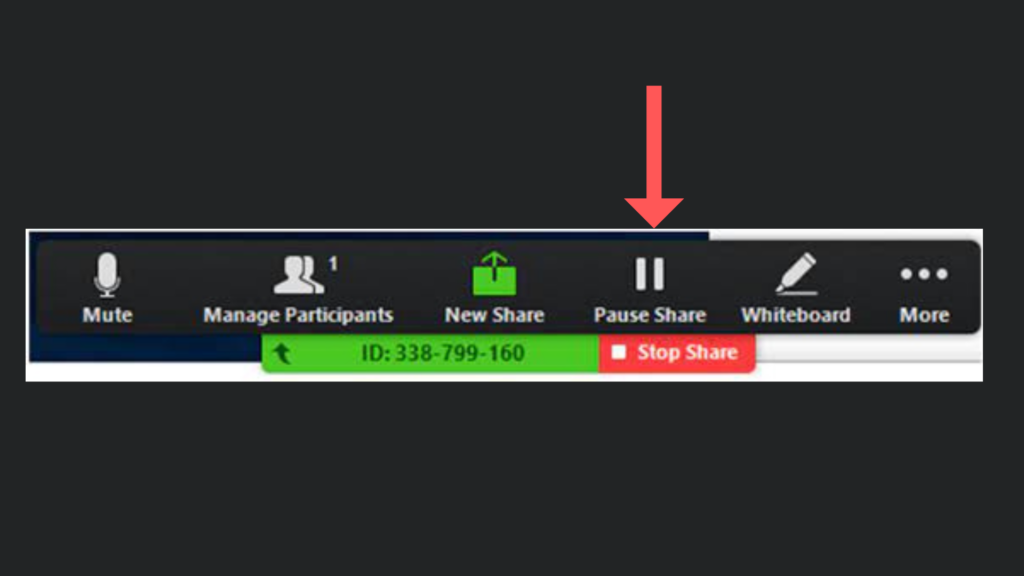What Happens When You Pause Share on Zoom?

Among Zoom’s array of features, screen sharing stands out as a critical tool for interactive and engaging presentations. But to utilize it effectively, understanding the nuances of its controls is key. One such control, the ‘Pause Share’ function, can be a game-changer for your Zoom experience.
So, what happens when you pause share on Zoom? How can you use this feature to manage your presentations better, protect your privacy, and improve the overall flow of your meetings?
In this article, we delve into the workings of Zoom’s ‘Pause Share’ feature, providing practical guidance on its usage and exploring various scenarios where it can be of immense value. Whether you’re an educator, business professional, or casual Zoom user, mastering the ‘Pause Share’ feature can significantly enhance your virtual interaction experience. Let’s dive in.
What is Screen Sharing on Zoom?

Screen sharing on Zoom is a feature that allows you to share the content of your screen with other meeting participants. This could be a presentation, a software demo, or even a casual browse through vacation pictures.
What Happens When You Pause Share on Zoom?

When you select the ‘Pause Share’ option while screen sharing, it essentially freezes the screen for other participants at the moment you pressed pause. During this pause, you are free to navigate away from the shared screen, open other windows or documents, or even make changes to the content on the screen you were sharing, without any of these actions being visible to the meeting attendees.
This is particularly useful when you need to access confidential or sensitive information, refer to personal notes, or even when you accidentally navigate away from the shared screen. It offers a layer of privacy and control over what content is visible to the meeting attendees at any given moment.
Once you’re ready to resume sharing, simply click on ‘Resume Share’. The screen will then be updated for the participants to see the current state of your screen, reflecting any changes you may have made during the pause. Keep in mind that the attendees do not see any of the actions you performed while the share was paused – they only see the screen as it is when you hit ‘Resume Share’.
The ‘Pause Share’ function is a powerful tool for maintaining professionalism and privacy during your Zoom meetings. It’s also a helpful feature for educators, presenters, and team leaders who need to manage their on-screen content while juggling multiple tasks during a virtual meeting or presentation.
While Zoom is designed to be intuitive, understanding the nuances of these features can greatly enhance your virtual communication experience. So next time you’re sharing your screen and need a moment to gather your thoughts, or fetch a different document, don’t hesitate to use the ‘Pause Share’ function.
Practical Use Cases for the ‘Pause Share’ Feature
Zoom’s ‘Pause Share’ feature offers a range of practical applications across various settings. Whether you’re an educator, business professional, or casual user, you can utilize this feature for a more streamlined and controlled screen sharing experience. Here are some practical use cases:
1. Education and Training Sessions: Educators can use ‘Pause Share’ when transitioning between different teaching materials or when they need to access an answer key or instructor notes. This ensures students only see what the educator intends to share, keeping the focus on the lesson content.
2. Business Presentations: During a business presentation, the presenter may need to switch between different documents, spreadsheets, or slides. Using ‘Pause Share’ prevents attendees from seeing any irrelevant or potentially sensitive information during these transitions.
3. Software Demos: When demonstrating a software or application, the presenter may need to enter login details or access backend features that shouldn’t be visible to the audience. ‘Pause Share’ can hide these actions while maintaining the flow of the demonstration.
4. Confidential Discussions: For professionals dealing with sensitive information, such as lawyers or HR executives, ‘Pause Share’ allows them to reference private documents during a Zoom meeting without exposing this information to other participants.
5. Personal Use: Even in less formal settings, ‘Pause Share’ can be useful. For example, if you’re sharing a video or game screen with friends, you can pause the share while adjusting settings or navigating through private messages.
6. Technical Troubleshooting: If an unexpected technical issue occurs during screen sharing, such as a software crash or slow loading time, ‘Pause Share’ can be used to suspend the share while resolving the issue, thus minimizing distractions for the participants.
In essence, ‘Pause Share’ can be a valuable tool for anyone needing to control what’s visible to others during a Zoom meeting. By using it wisely, you can maintain professionalism, protect privacy, and improve the overall flow of your presentations or discussions.
Step-By-Step Guide: How to Pause Share on Zoom
Zoom’s Pause Share feature is an invaluable tool for managing your screen sharing with precision and privacy. Here’s a step-by-step guide on how to use this feature:
Step 1: Start the Meeting
Launch your Zoom application and start a new meeting, or join an existing one. Remember, you must be the host or have host permission to share your screen.
Step 2: Initiate Screen Share
Once you’re in the meeting, locate the “Share Screen” button typically found at the bottom of the Zoom interface. Click on this button to start sharing your screen.
Step 3: Select What to Share
A new window will appear with various options of what you can share. This could be any open application or window, a whiteboard, or your entire screen. Select the desired option and click “Share”.
Step 4: Pause Share
Now that you’re sharing your screen, you’ll notice a new toolbar (usually at the top of your screen). One of the options on this toolbar is “Pause Share”. Clicking this will freeze the screen for all other meeting participants at the moment you pressed pause.
Step 5: Resume Share
When you’re ready to resume sharing, simply click on the “Resume Share” button in the same toolbar. Your screen share will update, and participants will see any changes made while the screen was paused.
Remember, anything you do on your computer while the screen share is paused is not visible to the other participants. You can confidently navigate away from the shared content, and attendees will only see the screen as it was when you paused it. Once you click “Resume Share”, your current screen view will be visible to the participants.
By following these steps, you can effectively manage your screen sharing on Zoom, ensuring your meetings run smoothly and professionally.
Do’s and Don’ts When Using ‘Pause Share’ on Zoom
Understanding the right way to use the ‘Pause Share’ feature on Zoom can enhance the quality of your meetings and presentations. Here are some do’s and don’ts to consider:
Do’s:
1. Do Use ‘Pause Share’ for Privacy: If you need to access confidential or private information during a meeting, use the ‘Pause Share’ feature. This ensures that you don’t accidentally share sensitive information with the meeting participants.
2. Do Pause When Switching Between Applications: When switching between different applications or files, use ‘Pause Share’. This will make your presentation more seamless and less distracting for your audience.
3. Do Use ‘Pause Share’ for Preparation: If you’re about to show a new slide or web page, you might want to load the content and check it first. Pause your screen share, prepare your content, and then resume sharing.
Don’ts:
1. Don’t Forget to Resume Share: It’s easy to forget to resume the share after pausing. Make sure you click ‘Resume Share’ so your audience can continue to follow along.
2. Don’t Assume You’re Not Visible: While ‘Pause Share’ does hide your screen, it doesn’t turn off your camera. If your video is on, participants can still see you even when the screen share is paused.
3. Don’t Overuse the Feature: While ‘Pause Share’ is a great tool for managing your presentation, frequent and unnecessary pauses can disrupt the flow of the meeting and distract participants. Use it judiciously.
4. Don’t Neglect Verbal Cues: When you pause or resume sharing, it’s good practice to verbally let your participants know. This way, they’re not left wondering why the screen froze or suddenly changed.
Understanding these do’s and don’ts can help you to use Zoom’s ‘Pause Share’ feature effectively, making your virtual meetings and presentations more professional and engaging.





